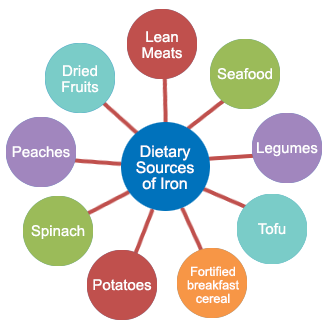Iron Facts
Iron in the Body
Iron is present in every cell in the body, though most is found in hemoglobin, which carries oxygen throughout the body. Iron is also essential in making new cells, amino acids, hormones and neurotransmitters.
The body holds onto and recycles iron; most iron losses occur from bleeding. If iron is not adequate in the diet, iron-deficiency can occur which typically causes tiredness, apathy and a tendency to feel cold.
In general, women need more iron than men. Women ages 19 to 50 need 18 mg per day while men ages 19 and older need 8 mg per day. Individuals who have increased needs for iron include pregnant women, some vegetarian women, and endurance athletes. Ask your health care provider if you have any concerns.
Iron is present in every cell in the body, though most is found in hemoglobin, which carries oxygen throughout the body. Iron is also essential in making new cells, amino acids, hormones and neurotransmitters.
The body holds onto and recycles iron; most iron losses occur from bleeding. If iron is not adequate in the diet, iron-deficiency can occur which typically causes tiredness, apathy and a tendency to feel cold.
In general, women need more iron than men. Women ages 19 to 50 need 18 mg per day while men ages 19 and older need 8 mg per day. Individuals who have increased needs for iron include pregnant women, some vegetarian women, and endurance athletes. Ask your health care provider if you have any concerns.
Tips for Optimizing Iron Intake
Eat vegetables and grains with lean meats to increase absorption
Choose lean meats and iron-rich legumes
Avoid drinking coffee or tea with meals
Eat iron-fortified foods
Cook foods in an iron pot if possible
Combine iron-rich foods with foods high in vitamin C to increase absorption
Food Sources of Iron
For more information visit:
Foods to Fight Iron Deficiency (EatRight.org)
Iron – National Institutes of Health
Iron - CDC
Sources:
Information adapted from the Institute of Medicine. Dietary Reference Intakes for Vitamin A, Vitamin K, Arsenic, Boron, Chromium, Copper, Iodine, Iron, Manganese, Molybdenum, Nickel, Silicon, Vanadium, and Zinc
1. Iron Dietary Supplements Fact Sheet. National Institutes of Health, Office of Dietary Supplements website. https://ods.od.nih.gov/factsheets/Iron-HealthProfessional/. Reviewed February 19, 2015. Accessed August 10, 2015.
2. Iron Fact Sheet for Consumers. National Institutes of Health, Office of Dietary Supplements website. https://ods.od.nih.gov/factsheets/Iron-Consumer/ Reviewed August 22, 2014. Accessed August 10, 2015.
USDA National Nutrient Database for Standard Reference Release 27.
| SOURCE | AVERAGE SERVING | IRON (MG) |
| SEAFOOD | ||
| Clams | 3 oz | 2.4 |
| Oysters | 3 oz | 7.8 |
| Sardines, canned with bone | 3 oz | 1.4 |
| Tuna, canned | 3 oz | 1.4 |
| MEAT AND POULTRY | ||
| Chicken (breast roasted) | 3 oz | 1.00 |
| Duck (flesh only, roasted) | 3 oz | 2.00 |
| Sirloin (lean, broiled) | 3 oz | 2.00 |
| Turkey (breast, roasted) | 3 oz | 1.20 |
| Turkey (drumstick) | 3 oz | 2.00 |
| LEGUMES | ||
| Lentils (cooked) | 1/2 cup | 3.30 |
| Lima beans (cooked) | 1/2 cup | 2.25 |
| Dried beans (cooked) | 1/2 cup | 2.30 |
| Split Peas (cooked) | 1/2 cup | 1.25 |
| Chickpeas (cooked) | 1/2 cup | 2.4 |
| Tofu (raw), firm | 1/2 cup | 3.3 |
| GRAIN PRODUCTS | ||
| Cream of Wheat (reg, cooked) | 1/2 cup | 6.00 |
| Fortified breakfast cereal (Total, e.g.) | 1/2 cup | 18.00 |
| Pasta (cooked), whole wheat | 1/2 cup | 0.75 |
| FRUITS AND VEGETABLES | ||
| Apricots (dried) | 1/4 cup | 1.50 |
| Broccoli (cooked) | 1/2 cup | 0.6 |
| Brussels Sprouts (cooked) | 1/2 cup | 1.00 |
| Figs (dried) | 1/4 cup | 0.8 |
| Peas (cooked) | 1/2 cup | 1.26 |
| Potato (cooked, with skin) | 1 medium | 1.9 |
| Raisins | 1/4 cup | 1.00 |
| Spinach (raw) | 1 cup | 1.00 |
| Spinach (boiled) | 1/2 cup | 2.00 |
| Squash (winter, acorn, cooked) | 1 cup | 1.9 |
| NUTS AND SEEDS, OTHER | ||
| Pistachios | 1/4 cup | 1.9 |
| Almonds | 1/4 cup | 1.3 |
| Molasses | 2 Tbsp | 1.9 |
Foods to Fight Iron Deficiency (EatRight.org)
Iron – National Institutes of Health
Iron - CDC
Sources:
Information adapted from the Institute of Medicine. Dietary Reference Intakes for Vitamin A, Vitamin K, Arsenic, Boron, Chromium, Copper, Iodine, Iron, Manganese, Molybdenum, Nickel, Silicon, Vanadium, and Zinc
1. Iron Dietary Supplements Fact Sheet. National Institutes of Health, Office of Dietary Supplements website. https://ods.od.nih.gov/factsheets/Iron-HealthProfessional/. Reviewed February 19, 2015. Accessed August 10, 2015.
2. Iron Fact Sheet for Consumers. National Institutes of Health, Office of Dietary Supplements website. https://ods.od.nih.gov/factsheets/Iron-Consumer/ Reviewed August 22, 2014. Accessed August 10, 2015.
USDA National Nutrient Database for Standard Reference Release 27.

